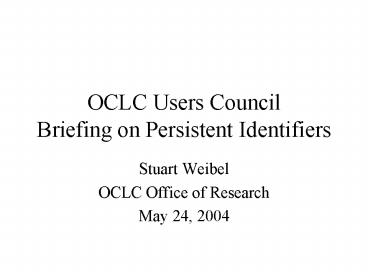OCLC Users Council Briefing on Persistent Identifiers - PowerPoint PPT Presentation
1 / 25
Title:
OCLC Users Council Briefing on Persistent Identifiers
Description:
Every cow, pair of socks, and razor blade (RFID) For the ... Problem: Identify these functional requirements and tailor identifier systems to meet them. ... – PowerPoint PPT presentation
Number of Views:42
Avg rating:3.0/5.0
Title: OCLC Users Council Briefing on Persistent Identifiers
1
OCLC Users CouncilBriefing on Persistent
Identifiers
- Stuart Weibel
- OCLC Office of Research
- May 24, 2004
2
Identity
- A globally ID for
- Every concept (term)
- Every resource
- Every objet dart
- Every agent
- Every cow,
pair of socks,
and razor blade (RFID)
3
For the Information World
- We care about identifying resources
- Physical
- Virtual
- Conceptual
- Knowing you have what you think you have
- Knowing youre talking about the same things
4
What do we want from Identifiers
- Reliability
- Resolvability
- Persistence throughout the life cycle of the
information object - What are the business models to support this?
5
Current efforts at OCLC involving persistent
Identifiers
- PURLs
- Open URLs
- info URIs
- ERRoLs
- Registration of terminology
6
- PURL Persistent Uniform Resource Locators
- PURLs look like URLs they ARE URLs
- PURLs emerged from OCLCs participation in the
IETF URN activity - A tool for managing names and namespaces since
1996
7
The 404 Problem
- Resources disappear
- Some are actually gone
- Disk reorganizations take place
- Changes in responsibility for resources occur
- URLs serve double duty as names and locators
- Making URLs symbolic names will improve their
usefulness
8
What is a PURL?
- PURL Persistent Uniform Resource Locators
- They look like URLs they ARE URLs
- No new technology, no new protocols
- A tool for managing names and namespaces
9
How PURLs Work
- PURLs take advantage of inherent redirection
facility in the HTTP protocol - PURLs provide an additional level of indirection
that maps a symbolic identifier to a network
location - PURLs work without plug-ins or other special code
in browsers they are just URLs - No New Technology added!
10
What does Persistentmean?
- Not a guarantee of perpetual access
- Not a magic solution to the 404 problem
- Not persistence of resources, but rather of the
names - PURLs are a tool that can be used to manage
resource names and locations with greater
reliability
11
Persistence derives from
- The social or contractual commitments of
organizations responsible for managing
information resources. - Technology can help, but the problem is, at its
heart, a social one.
12
PURL Server as a Redirection Server
http GET
Client
http redirect
http GET
Resource Server
resource
13
PURL Server as a Resource Server
http GET
Client
PURL Server
resource
14
Do I have to run my own PURL Server?
- OCLCs PURL Server is open to all, including the
ability to request domains - As of Monday, May 24, 2004
- PURLs Created 571 427
- PURLs Resolved 86 010 679
- Unique Client Systems 5 763 071
- The PURL server software is available at the
purl.org site for anyone to download and use
without cost or restriction.
15
How are PURLS different from DOIs?
- DOIs are a closely related identifier system
based on Handles - DOIs are a technology with a business model
wrapped around them - DOIs cost money
- The Commitment is the key
16
In Summary
- PURLs offer a methodology and tool set for
managing resource names and namespaces - Neither PURLs nor any other technology are a
replacement for policies or commitments to manage
resource names - PURLs represent a community-based solution
founded in freely available, widely deployed
technology. - http//purl.org
17
Identifiers for Concepts
- How do you use terminology in the Web World?
- The Semantic Web is about semantics exchanging
tokens of meaning between machines - Identifiers are a fundamental part of this.
18
Concepts can be expressed in language independent
ways (even if imperfectly)
- Vietnamese War, 1961-1975 (English language
version of DDC 22) DDC/22/eng//959.7043 - American War, 1961-1975 (Vietnamese
language version of DDC 22,)
DDC/22/vie//959.7043
19
Boundary-Free Community Terminologies
- Controlled Vocabularies have been with us for a
long time - Hypothesis there are specific functional
requirements that terminologies should embody in
order to be useful in the realization of the
Semantic Web
20
Terminology Identifiers
- Global, persistent identifiers that reflect the
functional characteristics of webulated
controlled vocabularies can help us remove
boundaries between and among communities and
disciplines. - Problem Identify these functional requirements
and tailor identifier systems to meet them.
21
INFO URIs
- An effort to provide a missing part of the naming
architecture of the Web - Separate resolution from identity
- Basis for the naming architecture of Open URLs
- Possibly useful in many other areas (terminology
identifiers)
22
INFO URIs(continued)
- Substantial controversy about separating identity
and resolution - IETF pushback is substantial
- Experimental use will determine future
23
ERRoLs
- Extensible Repository Resource Locators
- Constructed, Dynamic URLs that resolve to
metadata and content stored in a community of
OAI Repositories - A Service-based identifier
- See the Research Works pages for further
information
24
DCMI Working Groupon Persistent Identifiers
- Chartered to provide guidance about the use of
persistent identifiers in DC Metadata - Meeting in Feb of 2004
- Meeting at Persistent Identifier Symposium in
Cork, Ireland, in June - Survey and summarize use, provide guidance about
declaration and use.
25
Identity is more important than ever
- Information Resources
- People
- Terms
- Concepts
- Even cows
- In the end, it is about the reliability and trust
assets of the organizations that manage them































